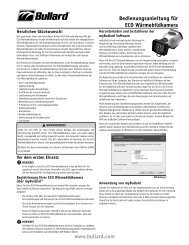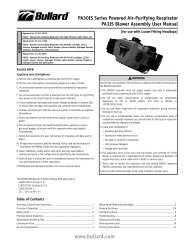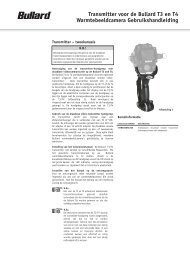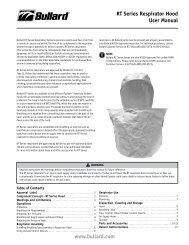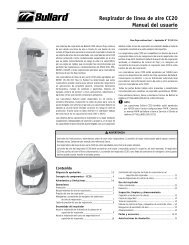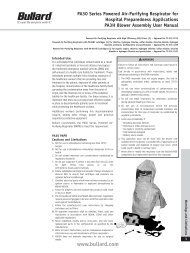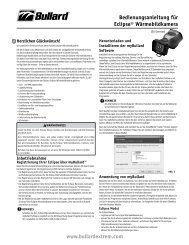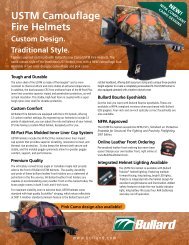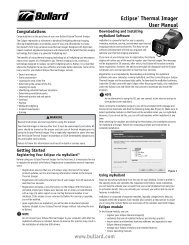Hazardous Locations Classifications - Bullard
Hazardous Locations Classifications - Bullard
Hazardous Locations Classifications - Bullard
Create successful ePaper yourself
Turn your PDF publications into a flip-book with our unique Google optimized e-Paper software.
EMERGENCY RESPONDER RESOURCE<br />
<strong>Hazardous</strong> <strong>Locations</strong> <strong>Classifications</strong><br />
A Guide to Practical Application of HazLoc for Emergency Responder Organizations<br />
Overview<br />
Many products for use in emergency services applications receive certification to hazardous locations (HazLoc) standards. The<br />
level, scope, and applicability of these vary based on the products’ inherent capability to meet these requirements, the market<br />
applications and user needs, and the geographic location where the products are being marketed and used.<br />
Due the complexity of these standards, emergency responders can become confused as to what the terminology means and what<br />
the benefits really are. This confusion is made worse by manufacturers that misunderstand and/or misrepresent the level or type<br />
of certification that their products actually attain.<br />
Non-Incendive vs. Intrinsic Safety<br />
Perhaps the most common concept Emergency Responder Organizations grapple with is that of Intrinsic Safety. Often,<br />
emergency responders seek products that are Intrinsically Safe without understanding what this term really represents. Further,<br />
manufacturers often claim their products to be Intrinsically Safe, when, in fact, their products are not.<br />
Intrinsic Safety and Non-Incendive are Protection Design Techniques, which also include Non-Sparking, Explosionproof,<br />
Pressurized, and others. These techniques are governed by various standards for specific applications.<br />
In North America, the most common HazLoc system is the Division system. In the Division system, products are first categorized<br />
by Class, which indicates if they protect against atmospheres that are contaminated with gasses and vapors (Class I), dust (Class<br />
II), or fibers and filings (Class III). NFPA 1801-2013, Standard on Thermal Imagers for the Fire Service requires adherence only<br />
to Class I atmospheres (see Table 1 for an overview of Class I Protection Design Techniques).<br />
Products are then sub-categorized by Division, which indicates the level of protection both when the product is operating in its<br />
“average” condition and when it is in an “unusual” condition. The average condition is normal operation; the unusual condition<br />
is when it is functioning abnormally. Further, the Division system details which gas or dust the product protects against and for<br />
what temperature ranges.<br />
For Class I atmospheres, the applicability of Intrinsically Safe versus Non-Incendive Protection Design Techniques is derived<br />
from the frequency of flammable concentrations of gases and vapors. If a product is to be used in atmospheres where these<br />
concentrations are normally present, then a product rated as Intrinsically Safe is appropriate. Where these concentrations are<br />
only present in abnormal situations, such as a leak, a product with a rating of “Non-Incendive” is acceptable.<br />
Table 1 – Summary of Class I Protection Design Techniques<br />
Class Division Where ignitable concentrations of flammable<br />
gases or vapors are present:<br />
Protection Design<br />
Technique<br />
Class I Division 1 For long periods of time under normal conditions Intrinsic Safety<br />
Class I Division 2 Only under abnormal conditions Non-Incendive<br />
Non <strong>Hazardous</strong> Area<br />
Not Applicable<br />
Perhaps most importantly, there is a misconception that products rated as Intrinsically Safe keep emergency responders that<br />
much safer. This can be true, but only in the very specific and unusual circumstances where an Intrinsically Safe product affords<br />
additional meaningful protection. Other product attributes, such as overall reliability, fitness for use, and general performance<br />
measures are far more likely to impact emergency responder safety. For instance, a thermal imager that is built to withstand high<br />
degrees of shock, heat, and other environmental elements is more likely to work at a call where reliability is severely tested than<br />
an imager that is built to a lower ruggedness standard. Most people would conclude that the more reliable product, because it<br />
has a better chance of remaining operational in such atmospheres, is “safer”.<br />
What these Protection Design Techniques mean for Emergency Responders<br />
For emergency responders, the first thing to understand is whether any Protection Design Technique is applicable for the<br />
atmospheres in which responders work. According to the Occupational Health and Safety Administration (OSHA), examples of<br />
Class I atmospheres, where flammable concentrations may exist under normal circumstances, are petroleum refineries and<br />
gasoline storage and dispensing areas; dry cleaning plants where vapors from cleaning fluids can be present; spray finishing<br />
areas; aircraft hangars and fuel servicing areas; and utility gas plants and operations involving storage and handling of liquefied<br />
petroleum gas or natural gas. Examples of Class I, Division 1 atmospheres that would require an Intrinsically Safe product, are<br />
“areas near open dome loading facilities or adjacent to relief valves in a petroleum refinery”.<br />
www.bullard.com
EMERGENCY RESPONDER RESOURCE<br />
Before specifying product requirements, Emergency Responder Organizations should ask themselves if and how they would<br />
respond to calls where explosive atmospheres are believed to be present. Do they understand the standards and protection<br />
factors in detail? Do they have guidelines and processes for how to respond to these calls? Do they know what types of<br />
equipment they should bring to these calls and how to appropriately use this equipment? Are responders adequately trained to<br />
respond in these environments? Would implementing compliancy standards and practices significantly reduce risk? Is the risk of<br />
putting responders into these situations warranted? There are a lot of questions that go well beyond merely looking at a rating on<br />
a product label and presuming safety.<br />
Practically speaking, responses to Class I, Division 1 atmospheres are rare, and organizations that do respond regularly to such<br />
situations would most likely utilize teams that are well versed in HazLoc principles and therefore thoroughly understand their<br />
equipment needs. For teams responding to these types of calls, equipment choices that meet intrinsic safety standards, whether<br />
flashlights, radios, or something else, are limited. For most everyone else, responses will rarely involve Division 1 atmospheres,<br />
as the vast majority of responses will not involve flammable concentrations as a normal condition. The National Fire Protection<br />
Association (NFPA) understood this need for a balance of safety and practicality when it did not make Intrinsic Safety a<br />
requirement for NFPA 1801-2013. Instead, NFPA specified Non-Incendive Class I, Division 2.<br />
Truth in Advertising?<br />
Partly due to the complexity of HazLoc standards and the temptation to play “fast and loose” with popular terminology, some<br />
manufacturers that have attained North American Class I, Division 2 (Non-Incendive) compliance for their thermal imagers<br />
incorrectly tout them as “Intrinsically Safe”. This can confuse customers who are comparing models and, at worst, create a<br />
misconception that a product meets a standard that it does not. The takeaway for Emergency Responder Organizations is that,<br />
when it comes to claims regarding Intrinsic Safety, the truth is often markedly different from what is printed on a brochure or<br />
listed on a website.<br />
Summary<br />
With the emergence of an NFPA standard for Thermal Imagers and its inherent requirement for Class I, Division 2 (Non-<br />
Incendive) compliance, <strong>Hazardous</strong> <strong>Locations</strong> terminology is making its way into the lexicon of the average emergency responder.<br />
Yet, the overwhelming technical complexity of the standards that make up HazLoc classifications creates challenging disconnects<br />
in marketing hype, market understanding, and actual user needs.<br />
The practice of adhering to the letter of HazLoc requirements goes well beyond simply buying a product that attains a certain<br />
rating and adding it to response toolkit. It also includes researching the requirements fully so that operating guidelines can<br />
be implemented to ensure safe and effective responses to incidents where HazLoc issues are present. There is a compelling<br />
argument that other product attributes, including product reliability, impact overall safety to a much greater extent and far more<br />
commonly than does a product’s adherence to a HazLoc standard.<br />
Emergency Responder Organizations must weigh the benefits of utilizing products that achieve certain HazLoc ratings against<br />
the actual costs of attempting to research, train, implement, and execute in accordance with HazLoc principles. In the potentially<br />
very small number of cases where responders may be in danger by their mere presence in highly flammable atmospheres, the<br />
effort of attempting to “get it completely right” may not be worth the risk.<br />
Sources:<br />
http://en.wikipedia.org/wiki/Intrinsic_safety<br />
http://en.wikipedia.org/wiki/Electrical_equipment_in_hazardous_areas<br />
http://www.fmglobal.com/page.aspx?id=50010107<br />
https://www.osha.gov/doc/outreachtraining/htmlfiles/hazloc.html<br />
Americas:<br />
<strong>Bullard</strong><br />
1898 Safety Way<br />
Cynthiana, KY 41031-9303 • USA<br />
Toll-free within the USA: 877-BULLARD (285-5273)<br />
Tel: +1-859-234-6616<br />
Fax: +1-859-234-8987<br />
Europe:<br />
<strong>Bullard</strong> GmbH<br />
Lilienthalstrasse 12<br />
53424 Remagen • Germany<br />
Tel: +49-2642 999980<br />
Fax : +49-2642 9999829<br />
www.bullard.com<br />
Asia-Pacific:<br />
<strong>Bullard</strong> Asia Pacific Pte. Ltd.<br />
LHK Building<br />
701, Sims Drive, #04-03<br />
Singapore 387383<br />
Tel: +65-6745-0556<br />
Fax: +65-6745-5176<br />
©2013 <strong>Bullard</strong>. All rights reserved.<br />
8490 (0813)



